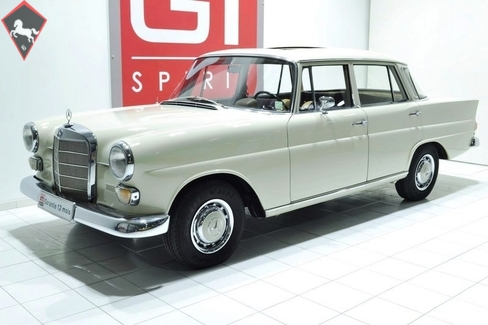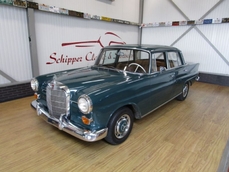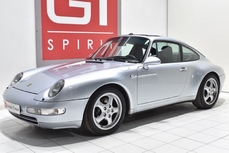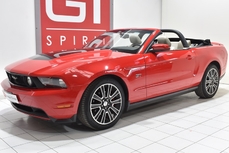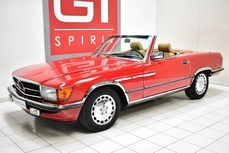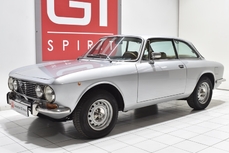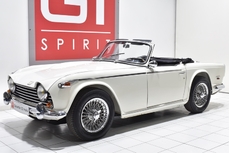Mercedes-Benz 230 w110 Fintail W110 1967
General description :
GARANTIE 12 MOIS INCLUSE
Frais de mise à la route en sus : 300 € TTC (plein de carburant, passage contróle technique, préparation intérieure et extérieure)
MERCEDES 230 (1961 - 1968)
40.258 exemplaires au total, dont 16.441 en 1967
Version 6 cylindres
Moteur M180
Deux carburateurs inversés Zénith 35/40
Carnet d'entretien d'origine
Manuel d'utilisation d'origine
Intérieur récent en simili cuir « Sable / Chocolat»
Boite automatique 4 rapports
Jantes tóle d'origine en 13’’
Enjoliveurs inox d'origine
4 pneumatiques FEDERAL
Toit ouvrant métal d'origine
Autoradio BECKER Europa d'origine
Instrumentation VDO d'origine
Montre VDO
Ceintures de sécurité avant
Volant d’origine en bakélite
Pommeau de levier de vitesse en bakélite
Allume cigare
Roue de secours
Cric
Historique du modéle :
Au début des années 60, MERCEDES adopte la mode du "Fintail" - arrêtes d'ailes en aileron de requin- sur sa toute nouvelle W110. En Juillet 1965, la gamme est revisitée et de nouvelles motorisations font leur apparition, notamment avec le six cylindres 230 remplaçant les blocs quatre cylindres moins nobles. Grâce à ce succés, la marque devient enfin un généraliste premium important, soucieux de la sécurité de ses nombreux clients. A ce titre la W110 sera la premiére berline MERCEDES à subir autant de crash tests.
Carrosserie / Extérieur :
Le modéle présenté ici est une MERCEDES 230 automatique d'Avril 1967, dans sa livrée ivoire d'époque.
La carrosserie est en trés bon état.
La peinture et les vernis présentent une brillance uniforme ainsi qu'une excellente profondeur.
Nous n'avons pas relevé de rayures ou d'éclats visibles.
La calandre et les pare-chocs chromés sont en trés bon état.
Le pare-chocs arriére présente une légére trace de frottement sur la partie centrale et quelques petits coups.
Les 4 jantes tóle d’origine en 13’’ sont en bon état, sans trace de choc ni déformation.
Ces derniéres sont chaussées de 4 pneumatiques FEDERAL affichant une usure de 10%
Les enjoliveurs en inox sont également en bon état malgré la présence de quelques coups / déformations et une légére oxydation des contours.
Cet exemplaire dispose de sa roue de secours d’origine ainsi que d’un cric.
Habitacle :
L’intérieur en simili cuir « Sable/Chocolat » est en excellent état.
La sellerie d’origine ne présente ni déchirure ni patine. Seule l’assise du siége passager présente une petite griffure (1cm).
LÂaccoudoir central arriére escamotable est parfaitement fonctionnel et en trés bon état.
Les contre-portes ne présentent aucune trace d’usure ou déchirure.
Le ciel de toit est parfaitement tendu et sans auréoles, attestant ainsi de la bonne étanchéité du toit ouvrant, option rare sur ce modéle.
Le volant en bakélite ainsi que le pommeau de levier de vitesse sont en excellent état, sans fissure ni cassure.
La partie centrale du volant en simili cuir présente une petite craquelure (1cm).
Les tapis PVC son en excellent état.
Le tableau de bord et ses équipements sont en trés bel état d'origine.
L'ensemble est parfaitement fonctionnel, à l'exception de la montre VDO et de l’autoradio BECKER EUROPA TR conservés pour des raisons esthétiques.
Cet exemplaire dispose de ceintures de sécurité à l’avant.
Châssis :
La mise sur le pont confirme une caisse saine, sans trace d'accident ni de corrosion structurelle.
Les fondamentaux: bas de caisse, bas d'ailes, passages de roue, planchers et longerons sont en trés bon état.
Réserve d'usage: par principe nous ne pouvons garantir la perfection des alignements au delà de leur bon état visuel et fonctionnel validé lors de l’essai sur route et de la mise sur le pont.
Lors de l'essai dynamique, nous n'avons relevé aucun bruit parasite anormal au niveau de la caisse ou des trains roulants (rotules, silentblocs...).
Le freinage est aligné, stable et conforme aux normes d’époque.
Les disques de frein avant affichent une usure inférieure à 20% et leurs plaquettes une usure inférieure à 40%.
Les tambours arriére sont parfaitement fonctionnels et exempts de traces de suintement.
Le passage au contróle technique réalisé par notre atelier en amont de la livraison confirmera le bon fonctionnement de l’ensemble.
Moteur / Transmission :
La mécanique fonctionne parfaitement.
Celle-ci a été contrólée dans nos ateliers.
La prise des compressions moteur effectuée lors de l’essai du véhicule confirme un 6 cylindres en excellente santé.
Le démarrage est immédiat, sans fumées ni bruit anormaux.
Le ralenti est stable.
La mécanique ne chauffe pas et prend ses tours sans irrégularités.
La pression d’huile relevée à froid est de 3 bars à 1.200 trs/min.
La boite automatique monte et descend les 4 rapports normalement, sans bruits suspects ni patinage excessif.
L'étanchéité moteur / boite de vitesse / pont reste moyenne.
La MERCEDES 230 fut l'une des premiéres berlines de grande série pour la firme allemande. A ce titre la W110 devance nettement ses concurrentes en terme de sécurité passive grâce aux nombreux crash-tests qu'elle a réussi. Cette version six cylindres essence reste aujourd'hui la plus recherchée car la plus noble, la plus fiable mais surtout la plus puissante de la série.
http://www.gt-spirit.fr/acheter-automobile/mercedes-230-w110,1303914.html?from_search=true
1967 Mercedes-Benz 230 w110 Fintail W110 is listed sold on ClassicDigest in La Boisse by Auto Dealer for Not priced.
Car Facts
Car type : Car Make : Mercedes-Benz Model : 230 w110 Fintail Model Version : W110 Engine size : 2.3 Model Year : 1967 Location : Prés Seigneurs
Sold
Seller Information
Sold
People who viewed this Mercedes-Benz 230 w110 Fintail also viewed similar Mercedes-Benz listed at ClassicDigest
Other cars listed for sale by this dealer
About Mercedes-Benz
In the annals of automotive history, the journey of Mercedes-Benz is a tale that unfolds with the ingenuity of its founding pioneers. In the year 1886, Karl Benz crafted the Benz Patent Motorwagen, a creation that would go down in history as the world's inaugural automobile. Unbeknownst to him, this moment marked the genesis of what would evolve into the most illustrious premium car manufacturer globally. The financial underpinning of this pioneering venture, interestingly, was provided by Karl Benz's wife, Bertha Benz, demonstrating a remarkable partnership that would set the tone for Mercedes-Benz's legacy.A parallel narrative emerged not far away, as Daimler-Motoren-Gesellschaft, founded by Gottlieb Daimler and Wilhelm Maybach, entered the scene. In 1901, they unveiled their automobile under the now-famous moniker "Mercedes," meaning "godsend" in Spanish. This name was bestowed upon the car at the behest of Emil Jellinek's daughter, the distributor for Daimler-Motoren-Gesellschaft. The wheels of innovation were set in motion.
Fast forward to 1926, a pivotal year that witnessed the merger of Daimler with Benz & Cie., culminating in the birth of Daimler-Benz. The amalgamation saw the adoption of "Mercedes-Benz" as the distinguished trademark for their automobiles, fusing the legacies of two visionary entities into one.
Contrary to perceptions of conservatism, the trajectory of Daimler-Benz unfolds as a chronicle of industry firsts. From the introduction of the honeycomb radiator to the float carburetor, and the pioneering implementation of four-wheel brakes in 1924, Daimler-Benz consistently pushed the boundaries of automotive innovation. The diesel-powered Mercedes-Benz 260 D in 1936 marked the inception of diesel engines in passenger cars. The iconic Mercedes-Benz 300SL Gullwing made history as the first car with direct fuel injection, albeit the Gutbrod's tiny 2-stroke engine can claim precedence.
Safety innovations became a hallmark, with Béla Barényi's patented safety cell design in the "Ponton"-models in 1951, featuring front and rear crumple zones. The W116 450SEL 6.9 saw the introduction of the Anti-Lock Brake system (ABS), another pioneering safety feature. From the first production airbags and beyond, the legacy of "firsts" continued to be etched into the fabric of Daimler-Benz.
Over its centennial journey, Mercedes-Benz has not merely produced cars but has sculpted automotive icons. The SSKL, 710 SSK Trossi Roadster, 770K Grosser, 540K Spezial Roadster, 300SL Gullwing, w100 600 Pullman, w111 280SE 3.5 Flachkühler, w113 230SL Pagoda, w109 300 SEL 6.3, and w201 2.3-16 Cosworth stand testament to the brand's commitment to engineering excellence.
The roaring Silver Arrows, or "Silberpfeile," including the W 25, W 125, W154, W165, and W196, created a legacy of dominance on the racetrack. These machines were not merely cars; they were expressions of precision, speed, and an indomitable spirit that left their competitors in the dust.
As Mercedes-Benz marches into the future, it does so not just as an automaker but as a custodian of a legacy, a torchbearer of innovation, and a beacon of automotive excellence. The road ahead is sure to witness the continued fusion of cutting-edge technology, timeless design, and an unwavering commitment to setting new standards in the world of automobiles.
One luminary figure who left an indelible mark was Béla Barényi, often heralded as the "father of passive safety" for his pioneering work in safety engineering. His patented safety cell design, featuring front and rear crumple zones, became a hallmark of Mercedes-Benz's commitment to occupant safety, setting new standards that reverberated throughout the automotive world.
Moving through the chronicles, the collaborative genius of Wilhelm Maybach, alongside Gottlieb Daimler, laid the foundation for Daimler-Motoren-Gesellschaft. Their innovations not only birthed the first Mercedes but established a culture of relentless pursuit of technological excellence that remains integral to Mercedes-Benz's DNA.
In the post-merger era of 1926, Ferdinand Porsche emerged as a prominent figure within Mercedes-Benz. His work on the Mercedes-Benz S-Type, a supercharged race car, garnered acclaim and set the stage for a legacy that extended far beyond the marque. Porsche's impact would later extend to his eponymous company, but his influence at Mercedes-Benz during those formative years was pivotal.
As the 20th century progressed, the legendary Rudolf Uhlenhaut emerged as a key figure. Uhlenhaut, an accomplished engineer and the driving force behind the iconic Silver Arrows, played a crucial role in Mercedes-Benz's dominance in motorsports. His engineering prowess and attention to detail were instrumental in creating some of the most formidable racing cars of the era.
In the latter half of the century, figures like Bruno Sacco, the head of design at Mercedes-Benz from 1975 to 1999, left an indelible imprint on the brand's aesthetic identity. Sacco's design philosophy, characterized by clean lines and timeless elegance, shaped iconic models like the W126 S-Class and the W201 190E, solidifying Mercedes-Benz's reputation for luxury and sophistication.
The narrative would be incomplete without acknowledging the contributions of engineers like Hans Scherenberg, whose leadership in the 1970s ushered in a new era of technological innovation at Mercedes-Benz. Scherenberg's tenure saw the development of groundbreaking technologies, including the Anti-Lock Brake system (ABS) and the introduction of airbags in production cars.
